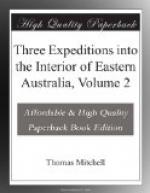A TRIBE COMES FORWARD.
September 21.
Early in the morning a tribe of about forty were seen advancing toward our camp preceded by the four men who had been previously there. Having determined that they should not approach us again, I made Piper advance to them and inquire what they wanted last night behind the bush, pointing at the same time to the spot. They returned no answer to this question, but continued to come forward until I ordered a burning bush to be waved at them and, when they came to a stand without answering Piper’s question, I ordered a party of our men to charge them, whereupon they all scampered off. We saw them upon our encamping ground after we had proceeded about two miles, but they did not attempt to follow us. Whether they would find a letter which I had buried there for Mr. Stapylton or not, we could only hope to discover after that gentleman’s return to the colony. It was understood between us that, where a cross was cut in the turf where my tent had stood, he would find a note under the centre of the cross. This I buried by merely pushing a stick into the earth and dropping into the hole thus made the note twisted up like a cigar. The letter was written chiefly to caution him about these natives. Basalt appeared in the sides of the ravine which contained the salt lakes and in equal abundance and of the same quality in that which enclosed the living stream where it lay in blocks forming small cliffs. Finding at length a favourable place for crossing this stream, we traversed the ravine and resumed our direct course towards the southern extremity of a distant range named Mammala by the natives, the bluff head previously seen from Mount Abrupt (see above).
FINE COUNTRY FOR COLONISATION.
We now travelled over a country quite open, slightly undulating, and well covered with grass. To the westward the noble outline of the Grampians terminated a view extending over vast plains fringed with forests and embellished with lakes. To the northward appeared other more accessible-looking hills, some being slightly wooded, some green and quite clear to their summits, long grassy vales and ridges intervening: while to the eastward the open plain extended as far as the eye could reach. Our way lay between distant ranges which in that direction mingled with the clouds. Thus I had both the low country, which was without timber, and the well wooded hills within reach, and might choose either for our route, according to the state of the ground, weather, etc. Certainly a land more favourable for colonisation could not be found. Flocks might be turned out upon its hills, or the plough at once set to work in the plains. No primeval forests required to be first rooted out, although there was enough of wood for all purposes of utility and as much also for embellishment as even a painter could wish.
HOLLOWS IN THE DOWNS.




